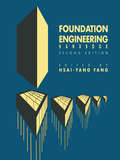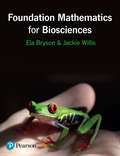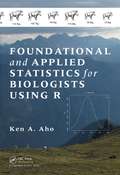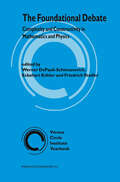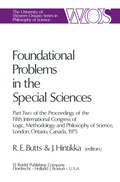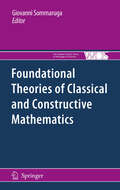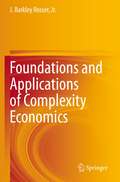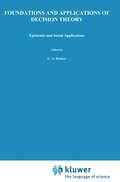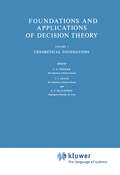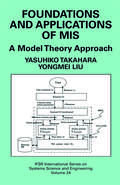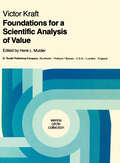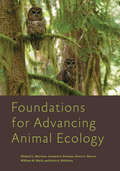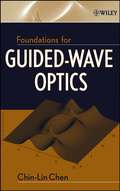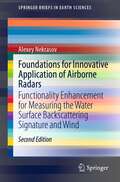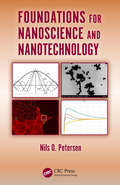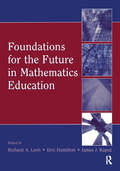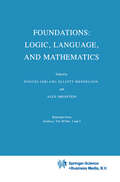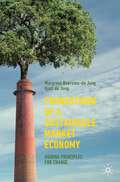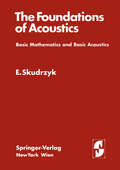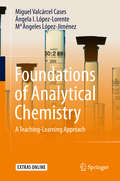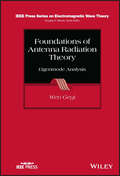- Table View
- List View
Foundation Engineering Handbook
by Hsai-Yang FangMore than ten years have passed since the first edition was published. During that period there have been a substantial number of changes in geotechnical engineering, especially in the applications of foundation engineering. As the world population increases, more land is needed and many soil deposits previously deemed unsuitable for residential housing or other construction projects are now being used. Such areas include problematic soil regions, mining subsidence areas, and sanitary landfills. To overcome the problems associated with these natural or man-made soil deposits, new and improved methods of analysis, design, and implementation are needed in foundation construction. As society develops and living standards rise, tall buildings, transportation facilities, and industrial complexes are increasingly being built. Because of the heavy design loads and the complicated environments, the traditional design concepts, construction materials, methods, and equipment also need improvement. Further, recent energy and material shortages have caused additional burdens on the engineering profession and brought about the need to seek alternative or cost-saving methods for foundation design and construction.
Foundation Mathematics for Biosciences
by Dr Jackie Willis Dr Ela BrysonFoundation Mathematics for Biosciences provides an accessible and clear introduction to mathematical skills for students of the biosciences. The book chapters cover key topic areas and their associated techniques, thereby presenting the maths in context. A student focused pedagogical approach will help students build their confidence, develop their understanding and learn how to apply mathematical techniques within their studies. Students will be able to use the book as a resource to complement their theory-based textbooks and to prepare themselves for practical classes, tutorials and research projects. Key featuresThe book progresses in a logical manner, opening with fundamental problems and then building to more complex calculations aligned to different disciplines in the biosciences.• Worked examples with detailed solutions provide step-by-step guidance through each calculation to help students build their practical skills.• Important rules and key points are highlighted in text boxes to help students consolidate their understanding of techniques and theory.• Illustrations provide insight into what students are likely to encounter in the laboratory. • Self-assessment questions are provided throughout to enable students to manage their learning and track their progress.• Learning objectives and key terms also help students to monitor their study. Suitable for students on courses from the pure end of the spectrum to more applied courses such as biomedical sciences, microbiology, molecular biology, physiology, and forensics. Dr Ela Bryson is Senior Lecturer in Molecular Biology at the School of Life and Medical Sciences at the University of HertfordshireDr Jackie Willis is Associate Dean of the School of Life and Medical Sciences at the University if Hertfordshire This book can be supported by MyMathLabGlobal, an online teaching and learning platform designed to build and test your understanding. The book and the MyMathLabGlobal system provide a range of benefits including:• A tool for the diagnosis of existing strengths and weaknesses in maths• A comprehensive set of algorithmically generated questions that can be used by students to practise and develop their skills in an independent and flexible manner and by the tutor to evaluate progress Need extra support?Were you looking for the book with access to MyXLab? This product is the book alone, and does NOT come with access to MyMathLabGlobal. Buy Title with MyMathLabGlobal access card (9780273774655) if you need access to MyMathLabGlobal as well, and save money on this resource. Ask your instructor about using MyLab.
Foundational and Applied Statistics for Biologists Using R
by Ken A. AhoFull of biological applications, exercises, and interactive graphical examples, Foundational and Applied Statistics for Biologists Using R presents comprehensive coverage of both modern analytical methods and statistical foundations. The author harnesses the inherent properties of the R environment to enable students to examine the code of complica
The Foundational Debate: Complexity and Constructivity in Mathematics and Physics (Vienna Circle Institute Yearbook #3)
by Werner DePauli-Schimanovich Eckehart Köhler F. StadlerConstructibility and complexity play central roles in recent research in computer science, mathematics and physics. For example, scientists are investigating the complexity of computer programs, constructive proofs in mathematics and the randomness of physical processes. But there are different approaches to the explication of these concepts. This volume presents important research on the state of this discussion, especially as it refers to quantum mechanics. This `foundational debate' in computer science, mathematics and physics was already fully developed in 1930 in the Vienna Circle. A special section is devoted to its real founder Hans Hahn, referring to his contribution to the history and philosophy of science. The documentation section presents articles on the early Philipp Frank and on the Vienna Circle in exile. Reviews cover important recent literature on logical empiricism and related topics.
Foundational Problems in the Special Sciences: Part Two of the Proceedings of the Fifth International Congress of Logic, Methodology and Philosophy of Science, London, Ontario, Canada-1975 (The Western Ontario Series in Philosophy of Science #10)
by Robert E. Butts Jaakko HintikkaThe Fifth International Congress of Logic, Methodology and Philosophy of Science was held at the University of Western Ontario, London, Canada, 27 August to 2 September 1975. The Congress was held under the auspices of the International Union of History and Philosophy of Science, Division of Logic, Methodology and Philosophy of Science, and was sponsored by the National Research Council of Canada and the University of Western Ontario. As those associated closely with the work of the Division over the years know weIl, the work undertaken by its members varies greatly and spans a number of fields not always obviously related. In addition, the volume of work done by first rate scholars and scientists in the various fields of the Division has risen enormously. For these and related reasons it seemed to the editors chosen by the Divisional officers that the usual format of publishing the proceedings of the Congress be abandoned in favour of a somewhat more flexible, and hopefully acceptable, method of pre sentation. Accordingly, the work of the invited participants to the Congress has been divided into four volumes appearing in the University of Western Ontario Series in Philosophy of Science. The volumes are entitled, Logic, Foundations of Mathematics and Computability Theory, Foun dational Problems in the Special Sciences, Basic Problems in Methodol ogy and Linguistics, and Historical and Philosophical Dimensions of Logic, Methodology and Philosophy of Science.
Foundational Theories of Classical and Constructive Mathematics (The Western Ontario Series in Philosophy of Science #76)
by Giovanni SommarugaThe book "Foundational Theories of Classical and Constructive Mathematics" is a book on the classical topic of foundations of mathematics. Its originality resides mainly in its treating at the same time foundations of classical and foundations of constructive mathematics. This confrontation of two kinds of foundations contributes to answering questions such as: Are foundations/foundational theories of classical mathematics of a different nature compared to those of constructive mathematics? Do they play the same role for the resp. mathematics? Are there connections between the two kinds of foundational theories? etc. The confrontation and comparison is often implicit and sometimes explicit. Its great advantage is to extend the traditional discussion of the foundations of mathematics and to render it at the same time more subtle and more differentiated. Another important aspect of the book is that some of its contributions are of a more philosophical, others of a more technical nature. This double face is emphasized, since foundations of mathematics is an eminent topic in the philosophy of mathematics: hence both sides of this discipline ought to be and are being paid due to.
Foundations and Applications of Complexity Economics
by J. Barkley Rosser, Jr.This book presents a survey of the aspects of economic complexity, with a focus on foundational, interdisciplinary ideas. The long-awaited follow up to his 2011 volume Complex Evolutionary Dynamics in Urban-Regional and Ecologic-Economic Systems: From Catastrophe to Chaos and Beyond, this volume draws together the threads of Rosser’s earlier work on complexity theory and its wide applications in economics and an expanded list of related disciplines. The book begins with a full account of the broader categories of complexity in economics--dynamic, computational, hierarchical, and structural--before shifting to more detailed analysis. The next two chapters address problems associated with computational complexity, especially those of computability, and discuss the Godel Incompleteness Theorem with a focus on reflexivity. The middle chapters discuss the relationship between entropy, econophysics, evolution, and economic complexity, respectively, with applications in urban and regional dynamics, ecological economics, general equilibrium theory, as well as financial market dynamics. The final chapter works to bring together these themes into a broader framework and expose some of the limits concerning analysis of deeper foundational issues.With applications in all disciplines characterized by interconnected nonlinear adaptive systems, this book is appropriate for graduate students, professors and practitioners in economics and related disciplines such as regional science, mathematics, physics, biology, environmental sciences, philosophy, and psychology.
Foundations and Applications of Decision Theory: Volume II: Epistemic and Social Applications (The Western Ontario Series in Philosophy of Science #13b)
by Clifford Ala Hooker, James J. Leach and Edward Francis McClennen1. INTRODUCTION In the Spring of 1975 we held an international workshop on the Foundations and Application of Decision Theory at the University of Western Ontario. To help structure the workshop into ordered and manageable sessions we distri buted the following statement of our goals to all invited participants. They in turn responded with useful revisions and suggested their own areas of interest. Since this procedure provided the eventual format of the sessions, we include it here as the most appropriate introduction to these collected papers result ing from the workshop. The reader can readily gauge the approximation to our mutual goals. 2. STATEMENT OF OBJECTIVES AND RATIONALE (Attached to this statement is a bibliography; names of persons cited in the statement and writing in this century will be found referenced in the biblio graphy - certain 'classics' aSide. ) 2. 1. Preamble We understand in the following the Theory of Decisions in a broader sense than is presently customary, construing it to embrace a general theory of decision-making, including social, political and economic theory and applica tions. Thus, we subsume the Theory of Games under the head of Decision Theory, regarding it as a particularly clearly formulated version of part of the general theory of decision-making.
Foundations and Applications of Decision Theory: Volume I Theoretical Foundations (The Western Ontario Series in Philosophy of Science #13a)
by C. A. Hooker J. J. Leach E. F. McClennen1. INTRODUCTION In the Spring of 1975 we held an international workshop on the Foundations and Application of Decision Theory at the University of Western Ontario. To help structure the workshop into ordered and manageable sessions we distri buted the following statement of our goals to all invited participants. They in turn responded with useful revisions and suggested their own areas of interest. Since this procedure provided the eventual format of the sessions, we include it here as the most appropriate introduction to these collected papers result ing from the workshop. The reader can readily gauge the approximation to our mutual goals. 2. STATEMENT or OBJECTIVES AND RATIONALE (Attached to this statement is a bibliography; names of persons cited in the statement and writing in this century will be found referenced in the biblio graphy - certain 'classics' aside. ) 2. 1. Preamble We understand in the following the Theory of Decisions in a broader sense than is presently customary, construing it to embrace a general theory of deciSion-making, induding social, political and economic theory and applica tions. Thus, we subsume the Theory of Games under the head of Decision Theory, regarding it as a particularly clearly formulated version of part of the general theory of decision-making.
Foundations and Applications of MIS: A Model Theory Approach (IFSR International Series in Systems Science and Systems Engineering #24)
by Yasuhiko Takahara Yongmei LiuThis book presents a unique systems theory approach to management information system (MIS) development. It covers an outline of the approach, providing a theoretical foundation for MIS from the systems theoretic viewpoint before presenting practical applications ranging from a transaction processing system to a solver system. The author also describes his newly developed extended Prolog programming language, which helps take full advantage of the mathematical framework employed.
Foundations for a Scientific Analysis of Value (Vienna Circle Collection #15)
by V. KraftIn English-speaking countries Victor Kraft is known principally for his account of the Vienna Circle. ! That group of thinkers has exercised in recent decades a significant influence not only on the philosophy of the western world, but also, at least indirectly, on that of the East, where there is now taking place a slow but clearly irresistible erosion of dogmatic Marxism by ways of think ing derived from a modem scientific conception of the world. Kraft's work as historian of the Vienna Circle has led to his being classed, without further qua1ification, as a neo-positivist philosopher. It is, however, only partially correct to count him as such. To be sure, he belonged to the group named, he took part in its meetings, and he drew from it suggestions central to his own work; but he did not belong to the hard core of the Circle and was a con scious opponent of certain radical tendencies espoused, at least from time to time, by some of its members. Evidence of this is provided by the theory of value now presented in English translation, since no less a thinker than Rudolf Carnap had, originally at any rate, obeyed a very narrowly conceived criterion of sense and declared value judgements to be senseless.
Foundations for Advancing Animal Ecology (Wildlife Management and Conservation)
by Michael L. Morrison Leonard A. Brennan Bruce G. Marcot William M. Block Kevin S. McKelveyHow can we maximize the probability that a species of wild animal will persist into the future? This audacious book proposes that advancing animal ecology—and conservation itself—demands that we reenvision our basic understanding of how animals interact with their environments and with each other. Synthesizing where we are and where we need to go with our studies of animals and their environs, Foundations for Advancing Animal Ecology asserts that studies of animal ecology should begin with a focus on the behaviors and characteristics of individual organisms. The book examines• the limitations of classic approaches to the study of animal ecology• how organisms organize into collections, such as breeding pairs, flocks, and herds• how the broader biotic and abiotic environment shapes animal populations, communities, and ecosystems• factors underlying the distribution and abundance of species through space and time• the links between habitat and population• why communication between researchers and managers is key• specific strategies for managing wild animal populations and habitats in an evolutionary and ecosystem contextThroughout, the authors stress the importance of speaking a common and well-defined language. Avoiding vague and misleading terminology, they argue, will help ecologists translate science into meaningful and lasting actions in the environment. Taking the perspective of the organism of interest in developing concepts and applications, the authors always keep the potentially biased human perspective in focus. A major advancement in understanding the factors underlying wildlife-habitat relationships, Foundations for Advancing Animal Ecology will be an invaluable resource to professionals and practitioners in natural resource management in public and private sectors, including state and federal agencies, non-governmental organizations, and environmental consultants.
Foundations for Advancing Animal Ecology (Wildlife Management and Conservation)
by Michael L. Morrison Leonard A. Brennan Bruce G. Marcot William M. Block Kevin S. McKelveyHow can we maximize the probability that a species of wild animal will persist into the future? This audacious book proposes that advancing animal ecology—and conservation itself—demands that we reenvision our basic understanding of how animals interact with their environments and with each other. Synthesizing where we are and where we need to go with our studies of animals and their environs, Foundations for Advancing Animal Ecology asserts that studies of animal ecology should begin with a focus on the behaviors and characteristics of individual organisms. The book examines• the limitations of classic approaches to the study of animal ecology• how organisms organize into collections, such as breeding pairs, flocks, and herds• how the broader biotic and abiotic environment shapes animal populations, communities, and ecosystems• factors underlying the distribution and abundance of species through space and time• the links between habitat and population• why communication between researchers and managers is key• specific strategies for managing wild animal populations and habitats in an evolutionary and ecosystem contextThroughout, the authors stress the importance of speaking a common and well-defined language. Avoiding vague and misleading terminology, they argue, will help ecologists translate science into meaningful and lasting actions in the environment. Taking the perspective of the organism of interest in developing concepts and applications, the authors always keep the potentially biased human perspective in focus. A major advancement in understanding the factors underlying wildlife-habitat relationships, Foundations for Advancing Animal Ecology will be an invaluable resource to professionals and practitioners in natural resource management in public and private sectors, including state and federal agencies, non-governmental organizations, and environmental consultants.
Foundations for Guided-Wave Optics
by Chin-Lin ChenA classroom-tested introduction to integrated and fiber optics This text offers an in-depth treatment of integrated and fiber optics, providing graduate students, engineers, and scientists with a solid foundation of the principles, capabilities, uses, and limitations of guided-wave optic devices and systems. In addition to the transmission properties of dielectric waveguides and optical fibers, this book covers the principles of directional couplers, guided-wave gratings, arrayed-waveguide gratings, and fiber optic polarization components. The material is fully classroom-tested and carefully structured to help readers grasp concepts quickly and apply their knowledge to solving problems. Following an overview, including important nomenclature and notations, the text investigates three major topics: Integrated optics Fiber optics Pulse evolution and broadening in optical waveguides Each chapter starts with basic principles and gradually builds to more advanced concepts and applications. Compelling reasons for including each topic are given, detailed explanations of each concept are provided, and steps for each derivation are carefully set forth. Readers learn how to solve complex problems using physical concepts and simplified mathematics. Illustrations throughout the text aid in understanding key concepts, while problems at the end of each chapter test the readers' grasp of the material. The author has designed the text for upper-level undergraduates, graduate students in physics and electrical and computer engineering, and scientists. Each chapter is self-contained, enabling instructors to choose a subset of topics to match their particular course needs. Researchers and practitioners can also use the text as a self-study guide to gain a better understanding of photonic and fiber optic devices and systems.
Foundations for Innovative Application of Airborne Radars: Functionality Enhancement for Measuring the Water Surface Backscattering Signature and Wind (SpringerBriefs in Earth Sciences)
by Alexey NekrasovThis book discusses methods for measuring the water surface backscattering signature and estimating the near-surface wind vector over water using airborne radars, in addition to their standard application. Airborne FMCW demonstrator system, Doppler navigation system, airborne weather radar, airborne radar altimeter, and airborne precipitation radar are analyzed in order to be used for that purpose. The radars functionality is enhanced for their operation in a scatterometer mode. A circle flight and/or a rectilinear flight of an aircraft over the water surface is considered depending on the radar design features to perform measurements of the azimuth normalized radar cross section curve of the water surface and/or the near-surface wind speed and direction. Flight recommendations to perform measurements along with algorithms for measuring the water surface backscattering signature and for retrieval of the wind speed and direction over water are presented.
Foundations for Nanoscience and Nanotechnology
by Nils O. PetersenDo you ever wonder why size is so important at the scale of nanosystems? Do you want to understand the fundamental principles that govern the properties of nanomaterials? Do you want to establish a foundation for working in the field of nanoscience and nanotechnology? Then this book is written with you in mind. Foundations for Nanoscience and Nanotechnology provides some of the physical chemistry needed to understand why properties of small systems differ both from their constituent molecular entities and from the corresponding bulk matter. This is not a book about nanoscience and nanotechnology, but rather an exposition of basic knowledge required to understand these fields. The collection of topics makes it unique, and these topics include: The concept of quantum confinement and its consequences for electronic behaviour (Part II) The importance of surface thermodynamics for activity and interactions of nanoscale systems (Part III) The need to consider fluctuations as well as mean properties in small systems (Part IV) The interaction of light with matter and specific applications of spectroscopy and microscopy (Part V) This book is written for senior undergraduates or junior graduate students in science or engineering disciplines who wish to learn about or work in the areas of nanoscience and nanotechnology, but who do not have the requisite background in chemistry or physics. It may also be useful as a refresher or summary text for chemistry and physics students since the material is focused on those aspects of quantum mechanics, thermodynamics, and statistical mechanics that specifically relate to the size of objects.
Foundations for Nanoscience and Nanotechnology
by Nils O. PetersenDo you ever wonder why size is so important at the scale of nanosystems? Do you want to understand the fundamental principles that govern the properties of nanomaterials? Do you want to establish a foundation for working in the field of nanoscience and nanotechnology? Then this book is written with you in mind. Foundations for Nanoscience and Nanotechnology provides some of the physical chemistry needed to understand why properties of small systems differ both from their constituent molecular entities and from the corresponding bulk matter. This is not a book about nanoscience and nanotechnology, but rather an exposition of basic knowledge required to understand these fields. The collection of topics makes it unique, and these topics include: The concept of quantum confinement and its consequences for electronic behaviour (Part II) The importance of surface thermodynamics for activity and interactions of nanoscale systems (Part III) The need to consider fluctuations as well as mean properties in small systems (Part IV) The interaction of light with matter and specific applications of spectroscopy and microscopy (Part V) This book is written for senior undergraduates or junior graduate students in science or engineering disciplines who wish to learn about or work in the areas of nanoscience and nanotechnology, but who do not have the requisite background in chemistry or physics. It may also be useful as a refresher or summary text for chemistry and physics students since the material is focused on those aspects of quantum mechanics, thermodynamics, and statistical mechanics that specifically relate to the size of objects.
Foundations for the Future in Mathematics Education
by Richard A. Lesh Eric Hamilton James J. KaputThe central question addressed in Foundations for the Future in Mathematics Education is this: What kind of understandings and abilities should be emphasized to decrease mismatches between the narrow band of mathematical understandings and abilities that are emphasized in mathematics classrooms and tests, and those that are needed for success beyond school in the 21st century? This is an urgent question. In fields ranging from aeronautical engineering to agriculture, and from biotechnologies to business administration, outside advisors to future-oriented university programs increasingly emphasize the fact that, beyond school, the nature of problem-solving activities has changed dramatically during the past twenty years, as powerful tools for computation, conceptualization, and communication have led to fundamental changes in the levels and types of mathematical understandings and abilities that are needed for success in such fields. For K-12 students and teachers, questions about the changing nature of mathematics (and mathematical thinking beyond school) might be rephrased to ask: If the goal is to create a mathematics curriculum that will be adequate to prepare students for informed citizenship—as well as preparing them for career opportunities in learning organizations, in knowledge economies, in an age of increasing globalization—how should traditional conceptions of the 3Rs be extended or reconceived? Overall, this book suggests that it is not enough to simply make incremental changes in the existing curriculum whose traditions developed out of the needs of industrial societies. The authors, beyond simply stating conclusions from their research, use results from it to describe promising directions for a research agenda related to this question. The volume is organized in three sections: *Part I focuses on naturalistic observations aimed at clarifying what kind of “mathematical thinking” people really do when they are engaged in “real life” problem solving or decision making situations beyond school. *Part II shifts attention toward changes that have occurred in kinds of elementary-but-powerful mathematical concepts, topics, and tools that have evolved recently—and that could replace past notions of “basics” by providing new foundations for the future. This section also initiates discussions about what it means to “understand” the preceding ideas and abilities. *Part III extends these discussions about meaning and understanding—and emphasizes teaching experiments aimed at investigating how instructional activities can be designed to facilitate the development of the preceding ideas and abilities. Foundations for the Future in Mathematics Education is an essential reference for researchers, curriculum developers, assessment experts, and teacher educators across the fields of mathematics and science education.
Foundations for the Future in Mathematics Education
by Richard A. Lesh; Eric Hamilton; James J. KaputThe central question addressed in Foundations for the Future in Mathematics Education is this: What kind of understandings and abilities should be emphasized to decrease mismatches between the narrow band of mathematical understandings and abilities that are emphasized in mathematics classrooms and tests, and those that are needed for success beyond school in the 21st century? This is an urgent question. In fields ranging from aeronautical engineering to agriculture, and from biotechnologies to business administration, outside advisors to future-oriented university programs increasingly emphasize the fact that, beyond school, the nature of problem-solving activities has changed dramatically during the past twenty years, as powerful tools for computation, conceptualization, and communication have led to fundamental changes in the levels and types of mathematical understandings and abilities that are needed for success in such fields. For K-12 students and teachers, questions about the changing nature of mathematics (and mathematical thinking beyond school) might be rephrased to ask: If the goal is to create a mathematics curriculum that will be adequate to prepare students for informed citizenship—as well as preparing them for career opportunities in learning organizations, in knowledge economies, in an age of increasing globalization—how should traditional conceptions of the 3Rs be extended or reconceived? Overall, this book suggests that it is not enough to simply make incremental changes in the existing curriculum whose traditions developed out of the needs of industrial societies. The authors, beyond simply stating conclusions from their research, use results from it to describe promising directions for a research agenda related to this question. The volume is organized in three sections: *Part I focuses on naturalistic observations aimed at clarifying what kind of “mathematical thinking” people really do when they are engaged in “real life” problem solving or decision making situations beyond school. *Part II shifts attention toward changes that have occurred in kinds of elementary-but-powerful mathematical concepts, topics, and tools that have evolved recently—and that could replace past notions of “basics” by providing new foundations for the future. This section also initiates discussions about what it means to “understand” the preceding ideas and abilities. *Part III extends these discussions about meaning and understanding—and emphasizes teaching experiments aimed at investigating how instructional activities can be designed to facilitate the development of the preceding ideas and abilities. Foundations for the Future in Mathematics Education is an essential reference for researchers, curriculum developers, assessment experts, and teacher educators across the fields of mathematics and science education.
Foundations: Logic, Language, and Mathematics
by AlexOrenstein ElliottMendelson HuguesLeblancThe more traditional approaches to the history and philosophy of science and technology continue as well, and probably will continue as long as there are skillful practitioners such as Carl Hempel, Ernest Nagel, and th~ir students. Finally, there are still other approaches that address some of the technical problems arising when we try to provide an account of belief and of rational choice. - These include efforts to provide logical frameworks within which we can make sense of these notions. This series will attempt to bring together work from all of these approaches to the history and philosophy of science and technology in the belief that each has something to add to our understanding. The volumes of this series have emerged either from lectures given by authors while they served as honorary visiting professors at the City College of New York or from conferences sponsored by that institution. The City College Program in the History and Philosophy of Science and Technology oversees and directs these lectures and conferences with the financial aid of the Association for Philosophy of Science, Psychotheraphy, and Ethics. MARTIN TAMNY RAPHAEL STERN PREFACE The papers in this collection stem largely from the conference 'Foun dations: Logic, Language, and Mathematics' held at the Graduate Center of the City University of New York on 14-15 November 1980.
Foundations of a Sustainable Market Economy: Guiding Principles for Change
by Margreet Boersma-de Jong Gjalt de JongThe free market underpins our economy and our way of thinking around enterprise and value, but it is also a major factor in the sustainability problems that we now live with. Climate change, child labour and oil spills are just a few of the many problems associated with our economic activity and, although many companies have made an effort to produce more sustainably, the pace of change is much too slow. This engaging and accessible textbook teaches students the relationship between the economy and sustainability, assessing the hand of the free market on company behaviour and, ultimately, providing a framework for transition to a sustainable economy.Using case studies and optional assessment questions, this textbook explains to students what a market is at the macro level and then translates the effects of the market to industries and subsequently to the strategic choices of companies at the micro level. It adopts a model of 8 guiding principles that underpin the current free market economy and 8 guiding principles for the sustainable market economy. Switching these deeply held principles will be essential to any serious transition to a sustainable economy.
The Foundations of Acoustics: Basic Mathematics and Basic Acoustics
by Eugen SkudrzykResearch and scientific progress are based upqn intuition coordinated with a wide theoretical knowledge, experimental skill, and a realistic sense of the limitations of technology. Only a deep insight into physical phenomena will supply the necessary skills to handle the problems that arise in acoustics. The acoustician today needs to be well acquainted with mathematics, dynamics, hydrodynamics, and physics; he also needs a good knowledge of statistics, signal processing, electrical theory, and of many other specialized subjects. Acquiring this background is a laborious task and would require the study of many different books. It is the goal of this volume to present this background in as thorough and readable a manner as possible so that the reader may turn to specialized publications or chapters of other books for further information without having to start at the preliminaries. In trying to accomplish this goal, mathematics serves only as a tool; the better our understanding of a physical phenomenon, the less mathematics is needed and the shorter and more concise are our computa tions. A word about the choice of subjects for this volume will be helpful to the reader. Even scientists of high standing are frequently not acquainted with the fundamentals needed in the field of acoustics. Chapters I to IX are devoted to these fundamentals. After studying Chapter I, which dis cusses the units and their relationships, the reader should have no difficulty converting from one system of units to any other.
Foundations of Analytical Chemistry: A Teaching–Learning Approach
by Miguel Valcárcel Cases Ángela I. López-Lorente Ma Ángeles López-JiménezThis book offers a completely new approach to learning and teaching the fundamentals of analytical chemistry. It summarizes 250 basic concepts of the field on the basis of slides. Each of the nine chapters offers the following features:• Introduction: Summary. General scheme. Teaching objectives.• Text containing the explanation of each slide.• Recommended and commented bibliography.• Questions to be answered.• Slides. A distinct feature of this novel book is its focus on the fundamental concepts and essential principles of analytical chemistry, which sets it apart from other books presenting descriptive overviews of methods and techniques.
Foundations of Antenna Radiation Theory: Eigenmode Analysis (IEEE Press Series on Electromagnetic Wave Theory)
by Wen GeyiFoundations of Antenna Radiation Theory Understand the theory and function of wireless antennas with this comprehensive guide As wireless technology continues to develop, understanding of antenna properties and performance will only become more critical. Since antennas can be understood as junctions of waveguides, eigenmode analysis—the foundation of waveguide theory, concerned with the unexcited states of systems and their natural resonant characteristics—promises to be a crucial frontier in the study of antenna theory. Foundations of Antenna Radiation Theory incorporates the modal analysis, generic antenna properties and design methods discovered or developed in the last few decades, not being reflected in most antenna books, into a comprehensive introduction to the theory of antennas. This book puts readers into conversation with the latest research and situates students and researchers at the cutting edge of an important field of wireless technology. The book also includes: Detailed discussions of the solution methods for Maxwell equations and wave equations to provide a theoretical foundation for electromagnetic analysis of antennas Recent developments for antenna radiation in closed and open space, modal analysis and field expansions, dyadic Green’s functions, time-domain theory, state-of-the-art antenna array synthesis methods, wireless power transmission systems, and more Innovative material derived from the author’s own research Foundations of Antenna Radiation Theory is ideal for graduate or advanced undergraduate students studying antenna theory, as well as for reference by researchers, engineers, and industry professionals in the areas of wireless technology.
Foundations of Antenna Radiation Theory: Eigenmode Analysis (IEEE Press Series on Electromagnetic Wave Theory)
by Wen GeyiFoundations of Antenna Radiation Theory Understand the theory and function of wireless antennas with this comprehensive guide As wireless technology continues to develop, understanding of antenna properties and performance will only become more critical. Since antennas can be understood as junctions of waveguides, eigenmode analysis—the foundation of waveguide theory, concerned with the unexcited states of systems and their natural resonant characteristics—promises to be a crucial frontier in the study of antenna theory. Foundations of Antenna Radiation Theory incorporates the modal analysis, generic antenna properties and design methods discovered or developed in the last few decades, not being reflected in most antenna books, into a comprehensive introduction to the theory of antennas. This book puts readers into conversation with the latest research and situates students and researchers at the cutting edge of an important field of wireless technology. The book also includes: Detailed discussions of the solution methods for Maxwell equations and wave equations to provide a theoretical foundation for electromagnetic analysis of antennas Recent developments for antenna radiation in closed and open space, modal analysis and field expansions, dyadic Green’s functions, time-domain theory, state-of-the-art antenna array synthesis methods, wireless power transmission systems, and more Innovative material derived from the author’s own research Foundations of Antenna Radiation Theory is ideal for graduate or advanced undergraduate students studying antenna theory, as well as for reference by researchers, engineers, and industry professionals in the areas of wireless technology.
